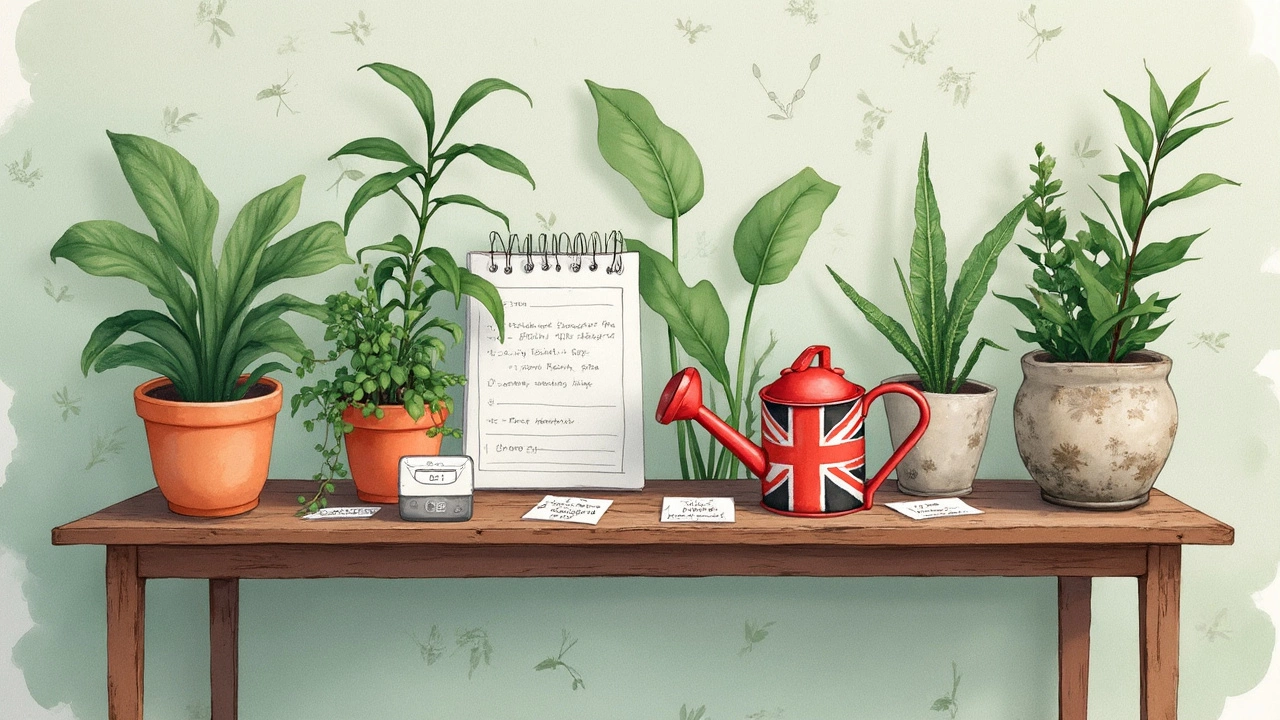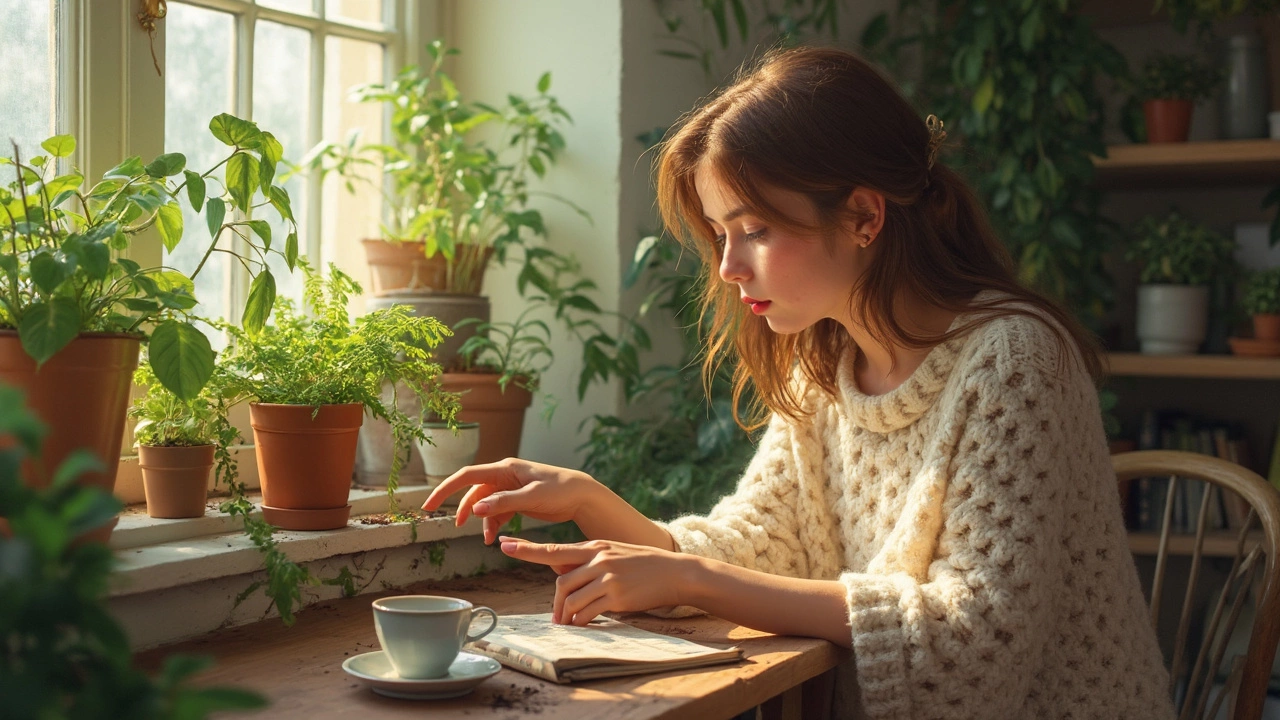If you’ve ever stood over your potted plant, finger hovering above your watering can, you’re not alone. Guessing when a plant really needs water trips up just about everyone—especially if you’ve killed a few through good intentions. The trick? You don’t need fancy tools. A few small checks can save you from root rot or crispy leaves.
Knowing when to water starts with the leaves. Wilting, drooping, and wrinkling are classic SOS signals from your plant. But here’s the kicker: some plants look sad even when they’ve had too much water. Don’t just judge by looks alone.
The real answer is in the soil. Stick your finger in about an inch deep (for small pots) or up to your second knuckle for bigger ones. If the soil feels dry that far down, it’s time to water. Still damp? Wait a bit. You don’t need a moisture meter—though, honestly, poking the dirt sometimes feels just as scientific.
- Spotting Visual Signs of Thirst
- Checking Soil Moisture Without Gadgets
- How Pot Size and Material Affect Watering
- Adjusting for Light, Humidity, and Temperature
- Common Mistakes: Over-Watering vs. Under-Watering
Spotting Visual Signs of Thirst
Catching the first visible clues is huge for indoor plant care. Most houseplants give you clear, physical signs when they're thirsty—if you know what to look for. Some plants are dramatic about it (like peace lilies, which flop right over), while others are more subtle.
Here’s what to watch for:
- Wilting or drooping leaves: This is usually the first major warning. For example, pothos and spider plants will get soft and limp when they need water.
- Dry or crispy leaf tips: If the ends of leaves start looking dry, brown, or crunchy, your plant is probably parched. Snake plants and dracaenas are classic for showing crispy tips when underwatered.
- Wrinkled leaves: Succulents like jade and Christmas cactus get shriveled and wrinkled leaves if they've gone too long without water. This is their way of telling you their built-in moisture reserves are running low.
- Dull or faded color: When leaves lose their shine and look pale, it's often a sign of thirst. Healthy, hydrated plants usually have that bright, vibrant green, not a dull grayish hue.
- Slow growth: If your plant was pushing out new leaves fast and suddenly stops, it's probably not getting enough water.
One quick test: gently squeeze a leaf. If it snaps or feels papery instead of flexible, that’s a red flag. But keep in mind—not all drooping is a sign of dryness. Overwatering can make leaves wilt, too, so always check the soil as well.
Take a look at this cheat sheet for easy reference:
| Plant Symptom | Likely Cause | Next Step |
|---|---|---|
| Wilting/drooping | Dry soil | Check soil, then water |
| Crispy leaf tips | Lack of moisture | Water soon |
| Wrinkled leaves | Dehydration | Give a good drink |
Noticing these signs before things get dire can literally save your houseplant. It makes your whole plant health routine way less stressful—no more guessing, just reading what your green buddy is telling you.
Checking Soil Moisture Without Gadgets
You really don’t need to spend money on moisture meters or fancy plant gadgets. Your finger is still the most reliable tool for checking watering plants needs. It’s what long-time plant lovers swear by, and it works for nearly any potted plant.
Here’s a no-nonsense way to do it:
- Wash your hands—mainly so you don’t transfer oils or bugs to your plant.
- Go knuckle-deep. For a small pot, poke your finger about an inch down. For bigger pots, aim for your second knuckle (roughly two inches).
- If the soil feels cool and a bit moist, skip watering for now.
- If the soil feels totally dry that far down, go ahead and water.
- If you don’t like using your finger, use a wooden chopstick or even a pencil. Stick it in and check for damp soil sticking to it. No dirt sticking = dry.
If you’re caring for a lot of indoor plants or have trouble remembering the last time you watered, some people mark their watering days on a calendar. But remember, not all plants dry out at the same rate. A snake plant in a shady corner might need watering every three weeks; a thirsty fern basking in the sun can get parched in five days.
Here’s a quick breakdown of typical dryness times for common houseplant types:
| Plant Type | Typical Soil Dry-Out Time |
|---|---|
| Snake Plant | 2-3 weeks |
| Pothos | 1-2 weeks |
| Peace Lily | 5-7 days |
| Succulents | 2-4 weeks |
No tool will beat the finger check for telling exactly what’s happening inside your pot. It’s high time we rely a little less on gear, and a little more on classic, hands-on indoor plant care.

How Pot Size and Material Affect Watering
It’s easy to overlook, but the size and material of your plant pot have a big say in how often you need to water. Grab a huge pot for a tiny plant, and the soil holds water way longer than your plant can use it. Roots end up sitting in soggy dirt, which can cause root rot—one of the most common killers for indoor plants. On the flip side, a plant crammed in a tiny pot dries out much faster, sometimes needing water every couple of days. The trick is finding that Goldilocks zone—a pot that’s not way bigger or smaller than the root system.
Material matters just as much. Terracotta and unglazed clay pots are pretty popular for a reason: they’re porous. That means water evaporates out the sides, so the soil dries out faster. Good for plants that hate wet feet, like succulents or cacti. But if you’re growing a plant that loves moisture, like a fern or a peace lily, plastic pots are usually better. They don’t let water escape as easily, so the soil stays damp longer. Ceramic pots fall somewhere in the middle, depending on whether they’re glazed or not.
Here’s a quick cheat sheet to keep things straight:
- Terracotta/Clay: Dries out fast; great for watering plants that prefer drier soil.
- Plastic: Holds moisture longer; good for thirsty houseplants.
- Ceramic (glazed): Similar to plastic; holds water, but usually looks nicer.
- Ceramic (unglazed): More like terracotta; lets soil breathe and dry out faster.
Size-wise, moving your plant to a slightly bigger pot when it outgrows its old one makes sense. But don’t go overboard—a jump of 1-2 inches in diameter is usually enough for most houseplants.
Want to know how long different materials keep soil damp? Check this quick reference:
| Pot Material | Water Retention (Approximate) |
|---|---|
| Terracotta/Clay | Low (dries in 2-4 days) |
| Plastic | High (dries in 5-7 days) |
| Ceramic (Unglazed) | Medium-Low |
| Ceramic (Glazed) | Medium-High |
Lining pots with pebbles or getting ones with drainage holes helps too, but the main thing: pay attention to both size and what your pot is made from. Your indoor plant care routine will get much easier.
Adjusting for Light, Humidity, and Temperature
Don’t fall into the trap of one-size-fits-all watering. The amount of water your indoor plants need changes as light, humidity, and temperature shift—even with the same type of plant.
Let’s start with light. Brighter rooms or spots close to a sunny window cause your plant’s soil to dry out way faster. Plants might need water every few days in summer, but those chilling in a shady corner could go a week (or more) without a drink. If you’ve moved a plant closer to a grow light or new window, you’ve got to check it more often.
Humidity makes a difference, especially in apartments with blasting AC or central heat that sucks moisture out of the air. Dry air pulls water out of the leaves and soil faster. So, plants like ferns or calatheas start drooping and crisping up along the edges. Your solution? Increase humidity with a tray of pebbles and water under the pot, or run a humidifier nearby. Even grouping several indoor plants together helps—they create their own little microclimate.
Then there’s temperature. Warm rooms dry soil out quickly. A good example: in winter, the air inside gets dry and radiators keep it toasty, but sun exposure drops, so plants often grow slower. The trick is to check both soil and the season—sometimes you actually need to water less in winter, despite the dry air, because plants aren’t growing as fast.
Here’s a quick cheat sheet to help you adjust:
- If light goes up, check soil moisture more often.
- When humidity drops, water might dry out sooner—watch for crispy leaf edges.
- In warmer temps, expect faster evaporation, but slow growth in cooler rooms means less water needed.
| Condition | Watering Frequency |
|---|---|
| Bright, sunny, warm room | Check every 2-3 days |
| Low light, cool room | Check weekly |
| Dry air (low humidity) | Check more often |
| High humidity (humidifier, grouped plants) | Check less often |
The main thing is to keep the seasons and environment in mind. If your environment changes, your watering routine should too. Pay attention to conditions, not just calendar schedules. It’s the key to keeping those houseplants healthy and happy.

Common Mistakes: Over-Watering vs. Under-Watering
The most common trip-up in indoor plant care? Getting too trigger-happy with that watering can—or forgetting about it entirely. Both over-watering and under-watering can kill your plant, but they show themselves in different ways.
Over-watering is way more common, especially for beginners hoping to show their plants some extra love. What actually happens is roots sit in soggy soil, start to rot, and can't take up oxygen. Classic signs of over-watering include yellowing leaves, mushy stems, and even fungus gnats hovering around the pot. If the topsoil is still wet or your pot never seems to dry out, you’re likely over-doing it.
Under-watering often gets less attention, but it’s just as risky. This happens when you forget to check the soil or assume it’s still damp. Signs? Leaves get crispy or curl up, edges brown, and the plant might drop leaves suddenly. The soil feels bone dry, pulls away from the edges of the pot, or even hardens up.
- Over-watering: Mushy stems, yellow leaves, wet soil after several days, root rot smell, fungus gnats.
- Under-watering: Brown or crispy leaf tips, wilted or curled leaves, dry soil that pulls away from the edge, stunted growth.
Want a simple test? Pick up your plant—light as a feather usually means thirsty, heavy means hold off on watering. Always look for drainage holes too; pots with no drainage are just asking for water trouble.
| Symptom | Over-Watering | Under-Watering |
|---|---|---|
| Leaves | Yellow, limp | Brown, crispy |
| Soil | Wet, may smell bad | Dry, pulls from pot |
| Roots | Black, mushy | Dry, shriveled |
Check your plants regularly. Adjust your watering based on the season (plants need less in winter), the pot material, and how thirsty that specific plant is. Getting the balance right is the biggest thing you can do for healthy, happy houseplants.
